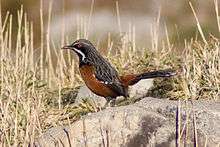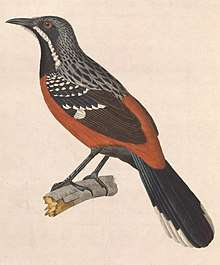Cape rockjumper
The Cape Rockjumper or rufous rockjumper (Chaetops frenatus) is a medium-sized insectivorous passerine bird endemic to the mountain Fynbos of southernmost South Africa.
| Cape rockjumper | |
|---|---|
 | |
| Scientific classification | |
| Kingdom: | Animalia |
| Phylum: | Chordata |
| Class: | Aves |
| Order: | Passeriformes |
| Family: | Chaetopidae |
| Genus: | Chaetops |
| Species: | C. frenatus |
| Binomial name | |
| Chaetops frenatus (Temminck, 1826) | |
Behavior and Ecology
Diet
Birds forage on rocky slopes and scree. Insects are the major part of the diet, although small vertebrates are reported to be taken by Cape Rockjumpers. A range of insects are taken, including caterpillars, moths, grasshoppers, beetles and flies. In addition to insects other prey include lizards and geckos, amphibians, scorpions, annelid worms and spiders. Their wings are proportionately small and they do not fly very often, although they will often take long gliding "flights" across valleys or downslope. They spend most of their lives running and jumping among rocks and grasses while hunting arthropods, small lizards, and amphibians.
Breeding
Family group territories near Cape Town vary in size from 4–11 ha (10–27 acres), but are larger out east [5]. Typically these grounds consist of a breeding pair and one or two additional individuals, usually offspring from from the preceding breeding season. These helpers participate in territorial defence and alarm calling, and in the feeding of nestlings and fledglings of the breeding pair. Both sexes help with nest building and incubation.
While an initial study from 2002 found Cape Rockjumpers attempt only one nest per season [6], a more recent study found they will attempt up to 5 nests per season if initial nests fail, and even re-nesting when they have had a successful nest [7].
Nests are built on the ground under rocky overhangs, and lined with either fur from red rock hare or old and fluffy protea seed pods. In general, nests are built under rocks on the downward facing slope to provide protection in inclement weather.
As ground nesters, Rockjumpers face large amounts of predation. Cape Rockjumper nest predation comes predominantly from the Boomslang, with this predation increasing at higher temperatures. They also experience predation from Cape Grey Mongoose, Honey Badger, Common Egg-eater, and African vlei rat [8]. While parents can deter Mongoose by harassing them, this is generally not successful to deter snakes. Although not recorded, it is also likely they experience predation from Chacma Baboon, Black-backed Jackal, White-necked Raven, and other snakes in the area (such as Cape Cobra or Puff Adder).
Nest success for Cape Rockjumpers is higher in territories that had more recent fire (within 3-5 years), possibly as there were fewer predators present.

Habitat
Cape Rockjumpers inhabit only mountain Fynbos, specifically that dominated by low scrubby restio vegetation. They prefer steep slopes with plenty of large boulders from which they can perch to keep an eye out for predators. While there is an established population at sea level at Rooi-Els (~ 80 km east of Cape Town), this area nevertheless is made up of mountain Fynbos habitat.
Appearance
This Rockjumper is 23–25 cm long with a long black tail and strong legs. The male has a dark grey and black head with a thin white supercilium and a broad white moustache (malar stripe). The back and wings are dark grey, and the underparts and rump are rufous red. The female and juvenile have a paler grey head, upperparts and wings, a duller head pattern, an orange rump, and buff underparts. The call varies from 1-4 piercing whistles to a series of trills. Adults have bright red eyes, while juveniles have black eyes until mature.
The closely related Drakensberg Rockjumper, Chaetops aurantius, does not overlap in range. The male of that species has orange underparts, and the female and young are paler below than the Cape Rockjumper.
References
- BirdLife International. 2017. Chaetops frenatus. The IUCN Red List of Threatened Species 2017: e.T22708094A118953543. https://dx.doi.org/10.2305/IUCN.UK.2017-3.RLTS.T22708094A118953543.en. Downloaded on 31 December 2018.
- Lepage, Denis. "Chaetops [frenatus or aurantius] (Rock Jumper) - Avibase". avibase.bsc-eoc.org. Retrieved 9 September 2017.
- Milne, R., Cunningham, S. J., Lee, A. T., & Smit, B. (2015). The role of thermal physiology in recent declines of birds in a biodiversity hotspot. Conservation Physiology, 3(1), cov048.
- Oswald, KN, ATK Lee, and B Smit (2018). Comparison of physiological responses to high temperatures in juvenile and adult Cape Rockjumpers (Chaetops frenatus). Ostrich. 89(4): 377-382.
- Oswald, KN, B Smit, ATK Lee, and SJ Cunningham (2019). Behaviour of an alpine-endemic bird is described mainly by interactions between microsite and air temperature. An Behav. 157: 177-187
- Richard T. Holmes, Bernhard D. Frauenknecht, Morné A. Du Plessis Breeding system of the Cape Rockjumper, a South African fynbos endemic, The Condor Volume 104, February 2002
- Oswald, KN, B Smit, ATK Lee, CL Peng, C Brock, SJ Cunningham. Under review. Reduced body condition for older nestlings is associated with higher temperatures in a range-restricted alpine bird. An. Beh.
- Oswald, KN, EF Diener, JP Diener, SJ Cunningham, B Smit, and ATK Lee (2020). Increasing temperatures increase the risk of reproductive failure in an alpine ground-nesting bird, the Cape Rockjumper Chaetops frenatus. Ibis. 10.1111/ibi.1284
External links


- Cape rockjumper - Species text in The Atlas of Southern African Birds.
